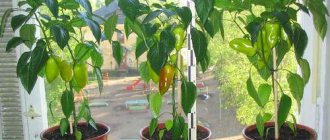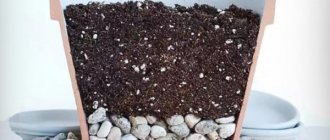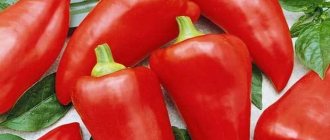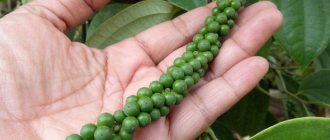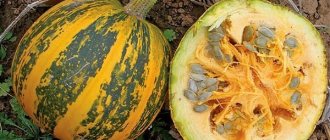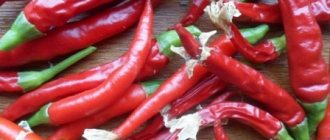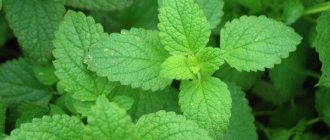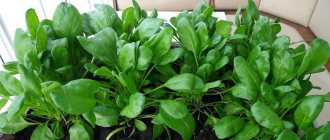Botanical features of ornamental pepper
Decorative peppers are given their spiciness by a special hot substance called capsacin (translated as “biting”). Pepper flowers are similar to potato flowers, but some have a rim around the edge of each petal.
Since ancient times, this plant has been grown in South America, Mexico and other countries as an aesthetic component, as well as for use in the preparation of local traditional dishes. For home breeding, special varieties were bred, the height of which did not exceed 1.5 m.
Ornamental pepper easily adapts to external conditions and produces a rich harvest. The fruits of different species differ in shape, color, and also in the nature of growth.
Is it possible to eat indoor peppers?
Only edible varieties of decorative peppers are used as food. These include:
- "Firework";
- "Aladdin";
- "Small miracle";
- "Ogonyok" and others.
Their fruits can be eaten raw and also used as a spice in cooking. If it is not possible to grow your own vegetables at your summer cottage, then many varieties of hot peppers are ideal for growing in apartment conditions.
Decorative peppers contain potassium and ascorbic acid, which are necessary for bones, so this culture is very useful for the human body (in the absence of stomach problems). Edible pepper promotes better functioning of the gastrointestinal tract, disinfects food and enhances the taste of the dish.
Preparatory work
When growing hot peppers at home, it is important to choose the soil, container and seed preparation wisely.
How to get planting material
To grow hot peppers, it is better to choose seeds taken from dried fruits. Alternatively, they can be purchased at specialized retail outlets or in online stores, which offer planting material for ornamental and exotic crops. If you sow it in February-March, you can count on a harvest in September-October. To successfully grow on a windowsill, you should choose the right seed material and carry out its pre-sowing preparation.
Pre-planting seed treatment
The choice of seeds should be focused on self-pollinating varieties; if you use other varieties, pollination will have to be done manually, which is not always convenient and effective. To speed up the germination process, purchased or collected seeds need to be kept in a container of water for several days. But they are first treated with a 1% solution of potassium permanganate, kept for 30 minutes. Wood ash is used as a natural growth stimulant; it is added to water for soaking seeds.
Soil and container for planting
The pots are filled either with ready-made seedling substrate, which is sold in specialized retail outlets, or with nutritious soil prepared independently from leaf soil (2 parts), peat (1 part), river sand (1 part), coconut fiber (1 part) and perlite ( 1 part). To avoid negative consequences for plantings in the form of the development of various kinds of diseases, the soil mixture is disinfected with fungicidal preparations such as Previkur. A 1% solution of potassium permanganate is suitable for these purposes.
To plant seeds in the ground, you will need separate 200 ml containers. To transplant an adult bush, it is better to take pots with a volume of over 3 liters.
Types of chilli peppers
There are five species of capsicum peppers grown in the world. Let's take a closer look at them.
Annual pepper (Capsicum annuum)
This pepper also has other names - annual capsicum, red pepper, annual pepper, paprika, vegetable pepper. This is a vegetable variety that has a sweetish taste (for example, bell pepper), but sometimes there are also spicy varieties (long-fruited, finger-shaped and other subspecies of chili). The peculiarity of this species is that after picking the fruits or shedding the plant, it dries out. But with careful care and proper growing conditions, annual peppers will bear fruit for a long time.
The bushes of such peppers have a small height, approximately 30-50 cm. The color and shape of the fruits depend on the variety of annual pepper.
Bush pepper (Capsicum frutescens)
Such perennial and pungent varieties, bearing fruit abundantly for 5-6 years, are perfectly adapted to growing in apartment conditions (on a windowsill, balcony, etc.). The number of fruits on one plant reaches 50 pieces. The second name for this decorative pepper is cayenne. The pepper is very hot.
Berry pepper (Capsicum baccatum)
Berry or berry pepper got its name due to its unusual shape. The most common varieties of this plant are “Bishop's Crown” (with average yield), “Lemon Lollipop” and “White Crystal”. Berry decorative pepper has an islandy taste.
The plant usually grows up to 80 cm, so is not suitable for growing on a windowsill.
Chinese pepper (Capsicum chinense)
The least widespread variety, due to slow growth, is the Chinese pepper variety (Habanero pepper). The height of the plant reaches 50 cm, the leaves are light green and oval. Pepper flowers are white-green.
The fruits resemble a lantern, but may differ among different varieties. The fruits of the plant are the hottest compared to other types of decorative indoor peppers.
Hairy pepper (Capsicum pubescens)
The second name for pepper is fluffy. It is also called “Rocoto” not only here, but also in Peru and Ecuador. The plant received this name due to the fact that the leaves are covered with villi. It is recommended to grow it in open ground, as the plant grows quite tall (3-4 m).
Fluffy peppers have a spicy taste and can be eaten raw.
Popular varieties for indoor growing
There are many varieties of indoor peppers. They differ in the appearance of the crown, leaves, fruits and color, and time of growth. In addition, each variety needs appropriate care to obtain the optimal amount of harvest.
Pepper variety "Aladdin"
One of the most valuable and widespread varieties of ornamental peppers, producing a large harvest (up to 1 kg). “Aladdin” can bear fruit for more than 5 years, growing up to 25 cm. During the growth process, the fruits acquire several colors:
- green;
- cream;
- purple;
- scarlet.
The variety has a pungent taste and aromatic smell. The plant is unpretentious and is excellent for growing indoors (on balconies and loggias). This type of pepper is usually used as a spice when you need to preserve vegetables or marinate meat.
Pepper "Ogonyok"
One of the most popular perennial varieties of ornamental pepper is Ogonyok, which grows up to 60 cm. It arose as a result of crossing Cayenne and Chilean species.
You can read about growing decorative chili peppers on a windowsill in our other article.
Typically, Ogonyok pepper ripens in the summer and autumn seasons, growing within 120-140 days. The fruits of Ogonyok are pear-shaped with a bright red hue. This species is very resistant to bacteria.
Pepper "Black Pearl"
One of the types of hot peppers with black colored leaves (this is why it got its name). The fruits of the plant have a spherical and slightly elongated shape, with a diameter of 1 cm.
As they grow, they change color from black and dark purple to scarlet and pink. A shade-tolerant species that grows up to 49 cm when grown in a pot, and reaches 150 cm when grown in a greenhouse.
Pepper "Little Miracle"
An ornamental variety with a pungent, pungent taste and cone-shaped fruits that turn green, purple and red as they grow. The height of the plant is no more than 30 cm. The little miracle is a type of decorative chili pepper and is used as a seasoning in the process of canning vegetables.
Pepper "Dragon"
This type of pepper is usually classified as a bush variety. The plant is suitable for growing in flower pots on a windowsill. The fruits of "Dragon" are cone-shaped, and the plant itself is resistant to weather conditions, so it can withstand prolonged exposure to the sun. Dragon fruits are commonly used as a seasoning in cooking.
Hot pepper "Salut"
A common ornamental plant that does not need to be pruned due to its ideal crown shape. The height of the bush does not exceed 20 cm, so it easily fits on the windowsill.
During the growing period, the color of the peppers changes from dark green to orange. The Salyut fruits are cone-shaped and ribbed; they are good to use as a seasoning when canning vegetables.
Apache pepper
A branching plant whose height reaches 30-40 cm. The bright red Apache fruits have a conical shape. The plant grows well within 80-90 days in pots of various sizes on the balcony or windowsill. The fruits of this variety are used as a seasoning in cooking.
Necessary agrotechnical conditions
When growing peppers in a pot, certain recommendations should be followed to maintain its decorative qualities and productivity. Only an integrated approach will allow you to obtain a strong and promising plant.
Choosing a place in the apartment
The best option for placing an ornamental plant would be a fairly sunny location. To increase the length of daylight, it is recommended to grow hot peppers on the windowsill of a south or east window. The leaves of the plant are acutely sensitive to direct sunlight, so in summer they need to be darkened.
To develop immunity, a pot of hot pepper is taken out to the balcony at night to artificially cause contrasting temperatures. It is good for the plant to change its location every 2-3 years or replant it to stimulate growth and development. If this condition is not met, the ability to bear fruit will cease after 5 years.
Illumination
A prerequisite for obtaining a rich harvest is a sufficient amount of sunlight. To fully satisfy the needs of indoor hot pepper, you need to place the pot on a windowsill with a southern, western or southwestern orientation. Considering the light-loving nature of the crop in spring and autumn, it should receive up to 3-4 hours of sunlight. You should not exceed these time limits, otherwise, instead of benefit, you can cause burns on the leaf plates.
When there is a shortage of sunlight, hot peppers are provided with an additional source of lighting in the form of fluorescent lamps.
Temperature and humidity
Heat-loving indoor pepper grows and develops effectively at room temperatures of up to 25 degrees - in spring and summer. As for winter, the temperature should be within 10-12 degrees. Air humidity is of particular importance for decorative piquant crops. In case of increased dryness, the plant will shed its leaves, and its fruits will have a wrinkled surface. In winter, regular leaf spraying will be useful for hot peppers on the windowsill.
Features of cultivation
Usually, seeds are sown no earlier than February. This is the most favorable time for indoor pepper to take root. To prepare seeds for sowing you need to purchase:
- disinfectant solution (phytosporin or potassium permanganate are suitable);
- growth stimulants.
When using the first solution, the seeds should be soaked during germination. If you use a growth stimulator, then the seeds need to be sprayed as stated in the instructions for the solution. When planting fresh seeds, such stimulation is not needed.
Seed germination technology
Instructions for properly growing ornamental pepper seeds:
- During germination, first place the seeds in water for 12 hours. The distance between them should be at least 2 cm so that the sprouted sprouts do not interfere with each other’s growth.
- Then sprinkle the sprouted sprouts with soil so that it covers the sprouts with a layer 1 cm thick.
- Next, you should spray the seeds with water using a spray bottle. The soil should be slightly moist to prevent mold and rot from appearing.
- The conditions for proper seed germination must correspond to greenhouse conditions: cover the sprouts with film and place them in a warm, lit place, but not in direct sunlight (otherwise a greenhouse effect will occur that is harmful to the seeds). The ambient temperature must be at least +23ºC.
- After the first shoots appear a few weeks later, remove the film.
Soil selection and preparation
It is recommended to use light neutral soil. It can be purchased at a special store or made independently. To do this, you will need to mix the following components in a 2:2:1 ratio:
- turf;
- leaf humus;
- sand.
In order to properly prepare the soil before growing ornamental peppers in it, saturate it with vermiculite or agroperlite. These components help the soil retain moisture well.
Transplanting a plant to a permanent place
As soon as the first leaves appear on the sprouts, you can begin replanting the seedlings. For each seedling you need to prepare a separate container (300 ml pot) in which to place them.
The plant may not bear fruit if several sprouts grow in the pot. It is also important that the size of the pot does not exceed the specified size, otherwise the root system of the bush will begin to oxidize when watering. Place a drainage layer at the bottom of the pot.
When transplanting a sprout, place it at the same depth as it was during germination. Immerse the sprout shallowly in the ground so that the roots of the decorative pepper do not rot.
Pin the main root - this helps strengthen the roots and better develop its lateral processes. Lightly press the area of soil around the sprout and then water thoroughly. During the rooting process, the bush does not need watering for a week.
Reproduction
Indoor peppers can be propagated in one of two ways:
- generative (from seeds);
- vegetative (using cuttings).
There are two methods to grow a plant from seeds. Sequence of actions for the first method:
- Select pots with a volume of 4 to 6 liters, fill them with soil, not forgetting to arrange a drainage layer.
- Pour the seeds into the water and leave to soak for 60 minutes. Then put them in a damp cloth for a day.
- Plant them in prepared containers and sprinkle a small amount of soil on top. The soil should be moist.
- Cover everything with film or glass and place it in a warm room. Remember the need for regular ventilation and moisture. As soon as the first 4 leaves appear, pinch the top to begin crown formation.
The second method is to grow seedlings and transplant them as they grow.
Forming peppers: 100 photos and video description of how to properly form sweet peppers in a greenhouse and open ground
Bell pepper benefits and harm: medicinal properties, contraindications for use and tips for growing yourself (125 photos)
Planting peppers: tips for growing and caring. Secrets of planting technology and instructions for beginner gardeners (130 photos and videos)
Propagation through cuttings can be carried out both in spring and summer. This method involves cutting off side shoots and placing them in separate pots for rooting.
If you love aesthetics, then be sure to buy yourself a decorative pepper. With its help you can decorate any window sill or balcony. In addition, its fruits will be useful when preparing culinary masterpieces.
Care and creation of favorable conditions
After all the procedures for planting seeds, it is important to provide the plant with proper care, which includes such basic steps as:
- watering and spraying;
- feeding.
Watering and fertilizing plants
In warmer months, peppers should be watered when the soil begins to dry out. In this case, the water for irrigation should be infused and at room temperature. Do not allow the soil to dry out too much, as the bush will wither and will not produce new fruits. Spray the plant several times a day if the ambient temperature exceeds +25ºC.
Sometimes the soil does not have enough nutrients needed by the plant, so it is necessary to fertilize homemade peppers. Purple color of the leaves means that the plant does not have enough phosphorus, and light color of the leaves indicates a lack of nitrogen.
The plant should be fed once every two weeks. The root is treated with a product containing potassium, and mixtures with nitrogen are applied to the leaves.
Selecting a location, lighting and temperature conditions
The room in which decorative peppers will grow should be well lit. It must be systematically ventilated, but avoid drafts.
The window sills on which the pots with the plant will stand should be on the east or west side, since the south has a stronger concentration of sunlight, and the plant can thus receive unwanted burns. But constantly being in the shade will not benefit the plant. The plant should be placed in the sun for 3 to 5 hours a day or you should create a light source yourself.
If the pepper branches develop poorly and there are few fruits, this indicates that the bush needs more solar heat. In November-December, when daylight hours are short, it is recommended to use a phytolamp.
The temperature in the room where indoor pepper will grow is +25ºC in spring and +16-19ºC in winter. Decorative peppers are not afraid of temperature changes, so they can be periodically placed on the balcony. The humidity in the room should be 60-70%. When the humidity level decreases after watering, spray the bush with a spray bottle.
Prevention of diseases and pests
Due to high soil moisture, ornamental peppers may develop root rot or a disease such as late blight, which appears as brown spots on the surface of the leaves. In this case, the pepper should be treated with products containing copper.
If the leaves of the plant begin to wither, this indicates the appearance of root rot. Remove the diseased plant from the ground and change the soil. Spider mites are also an enemy of ornamental peppers. It appears when the moisture concentration in the room is incorrect.
To prevent the appearance of mites, the plant should be watered regularly and maintain the required air humidity. If the mite has already infected the plant, then fungicides will help get rid of it. The root system can also be parasitized by mealybugs. To prevent the appearance of this pest, be sure to disinfect the soil before planting.
How to grow indoor peppers at home - all about caring for the “spark”
Capsicum peppers belong to the Solanaceae family; its varieties are divided into hot and sweet. The bitter taste comes from the alkaloid capsaicin.
Decorative indoor pepper stands out effectively on the windowsill and serves as a source of spices for preparing a wide variety of dishes. In everyday life it is called “light”, although in fact several dozen species and varieties of the plant are found in culture. What makes it popular is not only its pungent taste and attractive appearance, but also the ease of growing it at home.
- Choosing a variety and seeds for successful cultivation
- How to choose seeds for planting at home
- How to choose the best variety
- Seed germination technology
- Transplanting young plants to a permanent place
- Features of care and creation of conditions
- Stimulating flowering and fruiting
- What conditions do peppers need?
- Rules for harvesting and collecting seeds
- Caring for homemade peppers in a pot in winter
Choosing a variety and seeds for successful cultivation
The easiest way to propagate decorative indoor peppers is by seeds. The key to success is the correct choice of planting material.
How to choose seeds for planting at home
Seeds taken from dried fruit are excellent. You can purchase planting material in gardening stores or in online stores offering seeds of exotic and ornamental plants. If you start planting in February-March, you can easily get fruits already in September-October of the same year.
First, you need to decide what kind of pepper you want in the end - tall or short, spicy or not very hot, with fruits or berries or a classic “pepper” shape. As a rule, this information is on the bag. However, when purchasing, you need to pay attention to how long ago the seeds were collected?
Hot pepper seeds, when properly stored, can remain viable for up to 5 years, but every year the percentage of germination drops . It is better to grow indoor peppers from seeds collected last season if you plan to harvest this year.
The most important! The selected seeds should not have any defects - dark specks, strong curling, damage, or signs of rot. High-quality seeds are pale yellow, almost white.
How to choose the best variety
There are early ripening, mid ripening, late ripening. You can enjoy the fruits of early ripening varieties within 65-100 days from the moment of germination. Fruits from mid-season plants can be obtained in 100-120 days. But late-ripening varieties will be able to please you with a harvest only after 120-150 days.
Bush height . As a rule, lovers of indoor hot peppers prefer abundantly fruiting bushes up to 30 cm high - this is the optimal bush height for home pepper growing. There are also very miniature bushes of 15 cm, and real giants up to a meter high.
Fruit shape . Most lovers prefer peppers with a classic conical or elongated shape. The round, berry-like fruits are often mistaken for their close and poisonous relative, nightshade, and are considered inedible. This is not so - such pepper can also be eaten, but if you are not sure that it is not nightshade, then it is better not to risk it. There are also fruits of exotic shapes, for example, Aji orchid.
Color of fruits and leaves . This is especially important if you plan to grow the plant as an ornamental. There are very decorative varieties of indoor peppers, for example, Bolivian rainbow , Fish , which change their color several times as they ripen, and in the final stage of ripening can be yellow, orange or red.
The foliage of some varieties may also have inclusions of different colors - white spots and dashes, lilac stripes, which become brighter the sunnier the location of the plant.
Spicy - if you plan to eat the hot pepper harvest, it is important to make sure that you can do this - there are types that are not at all spicy, and there are some that are so bitter that it is unsafe for an unprepared person to eat them. Habanero is especially prized among gourmets - the fruits, depending on the variety, are spicy, but have an incomparable citrus-floral aroma and taste!
If you want to have hot peppers at home just for the sake of beauty, then spiciness is not important, but you should pay special attention to the decorative properties (height of the bush, shape and color, ripening characteristics).
Seed germination technology
A 300 ml plastic or ceramic flower pot is quite suitable for planting five seeds of hot indoor pepper. If you plan to plant in individual containers, you can choose smaller pots or use yogurt cups.
Step-by-step instructions for growing peppers from seeds at home:
- Pour drainage into the bottom of the container - expanded clay is best.
- Place soil on top. Usually choose a ph-neutral soil for houseplants or a mixture for peppers and tomatoes. Garden soil is not suitable, as it may contain insect larvae and fungal spores, which have a detrimental effect on seed germination.
- It is recommended to pre-soak the seeds in warm water for several hours for swelling and faster germination. Sometimes a stimulant is added to the soaking water, in particular Epin , to increase germination. The use of a stimulant will not affect the plant in the future, but if the seeds were collected 2-3 years ago, the likelihood of successful germination will be higher. Can be planted without soaking.
- Distribute the planting material evenly over the soil surface at a certain distance from each other. This is necessary so that as the young plants grow they do not interfere with each other.
- Sprinkle the seeds with soil on top - approximately 0.5 mm so that they are completely covered. If the surface of the soil is dry, moisten it with water, preferably using a flower spray bottle. It is important that the surface of the soil is slightly moist, but not wet - otherwise the seeds may rot.
- As the top layer of soil dries, it needs to be moistened regularly.
- It is advisable to place a plastic glass on top of the pot, thereby creating a greenhouse. This is especially true if planting takes place in February-March, and the room temperature may be below 25 degrees.
At a temperature of 22-25 degrees, seedlings appear in 10-14 days ; if the seeds were collected 2-3 years ago, the germination process may take another 1-2 weeks.
Seedlings need to be ventilated periodically - raise the greenhouse briefly so that the young plants get used to the environment. Gradually, the periods “without a greenhouse” should be increased, and eventually completely eliminated.
Transplanting young plants to a permanent place
When the seedlings have two pairs of true leaves, they need to be planted if the seeds were planted in one container. If the seedlings were planted in individual pots, then you can transplant the plants into larger pots when roots appear at the bottom of the water hole.
You should not leave all the plants in one pot. Decorative indoor hot peppers are grown according to the principle of one pot - one plant . The fact is that, when planted together, weaker specimens are “drowned out” by stronger ones. The weak ones will be greatly retarded in growth and development, flowering will be late and sparse, and fruiting may not occur at all.
When planting, it is better to use small deep pots of 100 ml each. Transplanting a young specimen immediately into a very large pot is not useful - the “extra” soil will begin to sour from watering. It is better, as the plant grows, to gradually transfer it into containers slightly larger than the previous one. The main sign that it is time to replant the plant is the roots peeking out from the bottom of the pot. During the season, as a rule, the bush is handled 2-3 times.
Features of care and creation of conditions
The goal of every home gardener is to see his plant bloom; in the case of decorative peppers, the end result is beautiful fruits decorating the garden on the windowsill.
Stimulating flowering and fruiting
Young seedlings of “light” on the windowsill begin to bloom approximately a month after germination. The first flowers will most likely be empty and fall off, but as they grow and develop, ovaries will appear and fruits will develop.
Special pollination is not required, but to increase the number of ovaries, you can periodically lightly shake the pot with the bush or “pollinate” the flowers with a soft brush.
Depending on what variety of indoor hot pepper you have grown (early-ripening, mid-ripening or late-ripening), the first fruits may appear in the summer, when the sun is most active, or in early to mid-autumn.
It is important to remember that hot peppers at home do not require pinching and intensive formation of the bush in the first year of growth, cutting off flowers and the first ovaries. The indoor pepper itself “knows” to what height it needs to grow, when to start blooming and how many fruits to set. Your task is to provide him with comfortable growth conditions.
What conditions do peppers need?
Sunny location . It is advisable to keep the pot on a windowsill indoors. On very sunny balconies, the “lights” suffer greatly from the rays, the leaves may be damaged, the flowers may fall off, and the fruits may be severely deformed and have no seeds.
In the shade, seedlings bloom reluctantly, set few fruits, and may suffer from flooding. Bushes of hot indoor decorative peppers feel extremely uncomfortable on shelves, refrigerators and closets – away from the sun and fresh air.
Regular watering and spraying are the main components of caring for peppers at home. Ogonyok loves water very much. In summer, on sunny days, the plant must be watered every day. Spray with water at room temperature, preferably twice a day.
Fertilizer . From March to September (and for late-ripening plants - until October), it is advisable to feed indoor peppers with specialized fertilizer for fruit plants. There is also a special fertilizer for peppers and tomatoes; it is found in stores for gardeners and flower growers.
Formation . In addition to the sun, water and a pot of sufficient volume, indoor hot peppers can be shaped as the branches grow - this is important in late summer and autumn for plants of the first year of life and in early spring, when it comes out of dormancy.
They shape, that is, trim branches that are too long - this gives a more tidy appearance and allows the plant to save energy. But you shouldn’t shorten the main trunk - this could cause the bush to die.
Rules for harvesting and collecting seeds
As the fruits ripen, the harvest can and should be harvested. There are varieties of indoor peppers, the pungency of which decreases when fully ripe. Therefore, such fruits are harvested at the stage of technical ripeness. Such unripe peppers often turn out to be much tastier than ripe ones.
For example, the fruits of the decorative bitter indoor pepper variety Jalapeno (Jalapeño) are most often harvested when they are still green, but characteristic “scars” have already appeared on them, but when they become red, this species already loses its taste value.
If you are interested in seeds for planting in the future, then you need to wait until the fruits are fully ripe, that is, they acquire their final color (yellow, orange or red). The fruits must be removed from the bush and allowed to dry for several days.
If the pepper is thin-walled, then it dries quickly enough; if it is thick-walled, then when the fruit wrinkles, it must be carefully cut and allowed to dry again for several days.
Then the seeds are carefully removed and laid out on a napkin to dry. Well-dried seeds can be placed in a bag and stored in a dry, dark place; storage in the refrigerator is allowed. The main thing is that moisture does not get in, in which case they can rot.
Caring for homemade peppers in a pot in winter
Contrary to popular belief, hot indoor peppers are perennial plants. On average, a bush can actively bear fruit for 5 years. The main thing is to reload the plant as it grows and renew the soil every spring. However, not all flower growers are ready to provide comfortable conditions for wintering for this handsome pet. Therefore, three options are possible.
First . If you do not want to save this specimen, at the end of the season after fruiting has ended, the bush can be thrown away, and in February-March a new plant can be grown from the obtained seeds.
Second . If you are ready to save the plant, then at the end of the season you need to collect the ripe fruits, reduce watering, and avoid allowing the soil to dry out for a long time. Spray the bush with water at room temperature every two to three days.
Gradually the leaves will partially fall off. Sometimes the pepper sheds its leaves completely. Branches that are too long can be shortened a little. In winter, new leaves and even flowers may appear on the branches, especially if the thaw lasts for a long time and the heating works intensively.
In February-March, indoor pepper will begin to grow again; at this moment it is necessary to transplant it into a pot slightly larger than the previous one, and replace the bulk of the soil. Gradually increase watering.
Third . If you not only want to preserve the plant, but also get a harvest in winter, then additional lighting is necessary. In this case, special lamps are installed, watering is not reduced, and fertilizing continues.
As you can see, growing ornamental peppers at home does not require special knowledge and skills. “Ogonyok” in a pot is perfect for those who don’t like to wait too long for the planted plant to finally bloom – it only takes 3-4 months from seed to beautiful and fragrant fruits.
If you love indoor plants, learn how to grow avocado from seed, plumeria and adenium from seed, and violet from leaf. Watching how a miracle is born is much more interesting than buying a ready-made flower in a store.
Hot peppers are added to confectionery, chocolate, coffee, tea - a very unusual and effective remedy in the fight against colds and flu!
Possible errors during cultivation and reviews
To avoid the most common mistakes when growing and caring for ornamental peppers, use the following tips:
- If you grow peppers on a windowsill, it is almost impossible to make a mistake. Only in strong sunshine should the plant be placed in the shade and systematically watered with settled water.
- If you are going to grow a pepper variety like Ogonyok, then be careful not to let the soil dry out. This type of pepper is too sensitive to a lack of moisture during its flowering period, so if there is a lack of water, it may begin to drop its buds.
- Avoid drafts and dry air to prevent the plant from dropping its leaves and going into hibernation.
- To ensure proper fruit set, shake the pepper bushes during the flowering period - this promotes the necessary pollination.
- When planting a plant, do not dig it too deep into the ground (the root collar should be lowered into the soil no more than 2 cm), otherwise it will die or the fruiting period will begin very late.
- In order not to confuse the dosage of the mixture for feeding peppers, buy ready-made ones in a special store. Organic approvals are best, especially if the pepper fruit will be eaten.
The most common diseases and pests
Did you know that ornamental peppers are rarely attacked by pests and rarely get sick? If pepper fruiting bushes are placed next to flowers, aphids and spider mites will not risk appearing nearby.
Author's note
Natalia Papanova
Blog author
Young individuals suffer from infections during the flowering and budding period.
Fungal diseases and methods of combating them
Author's note
Natalia Papanova
Blog author
Weakened and young specimens are susceptible to fungal diseases. Excess moisture causes fungus to settle on the bushes; I will describe in detail how I get rid of diseases.
Blackleg
Dark spots form on the trunk; blackleg disease affects the roots of the plant, trunk and leaves.
How to fight:
I destroy the disease with a solution of “Fitosporin” or “Zaslon” (3 caps per 1 liter of warm water). After treatment, I put the pot in a dark place for 3-4 days, without watering. If necessary, I carry out therapeutic watering again.
For prevention, I control watering and air temperature.
Late blight
The leaves become covered with brown spots, gray rot forms at their base and the leaves fall off.
How to get rid of:
- I dilute 2 tablets of the biological preparation “Gamair” per 1 liter of water.
- I spray the diseased plant 3 times every 7 days.
- I water it under the root with Fitosporin-M (1.5 tsp per 3 liters of water).
- I water again along with irrigation.
- I isolate the sick plant from others, for prevention, I reduce watering and add lighting.
Late blight disease on pepper
Fusarium
The leaves turn bright yellow and the pepper dies. It is rarely possible to save specimens infected with fusarium; I remove them from the pot and disinfect them.
How to disinfect:
- I throw away the diseased bush along with a lump of earth.
- I rinse the pot where the bush grew with manganese (1 g of manganese + 100 ml of water).
- After treatment, I remove the pot for six months for quarantine.
- I water at the root and irrigate healthy plants from a spray bottle for prevention with a solution of “Fitosporin” (1 tsp + 1 l of water).
Gray rot
A gray coating appears on the trunk in the area of the roots, without treatment it completely affects the bush.
How to get rid of:
- I remove the top layer (1.5 cm) of soil.
- To increase immunity, I water it with a solution of the drug “Zircon” (5 liter bottle).
- I spray it with a mixture of iodine 2 times every week (1 ml per 1 liter of water).
- I reduce watering to once every 7 days.
Brown spot
The top of the leaf becomes brown, the bottom has a gray coating. If not treated in time, the leaves will fall off and the pepper will lose half its harvest.
Treatment:
- I remove diseased leaves.
- I spray with Barrier solution (1 cap per 1 liter).
- I repeat irrigation after 3 days.
- Prevention - drying the soil, reducing watering.
Anthracnose
A dangerous fungal disease that completely destroys the plant in a short period of time. The leaves begin to become covered with dark sores that affect the entire bush.
Treatment of the disease:
- Before flowering, I water and irrigate with Zircon solution (2 liter ampoule).
- During fruiting, I spill “Fitosporin-M” (1 tsp + 1 l).
- I process (watering at the root and irrigation) after collecting the peppers with Bordeaux mixture (1 tsp copper sulfate + 2 tsp lime + 5 liters of water).
Dear readers, to protect peppers from fungi, follow the watering and temperature regime.
Garlic is an excellent assistant in the fight against fungal diseases. Find out how to store garlic at home and you will always have it at hand.
Viral diseases and methods of combating them
Dear friends, fungal diseases, unlike viral diseases, can be prevented by preventive measures. Viruses are carried through the air by insects. I’ll tell you how I rid peppers of viruses.
Tobacco mosaic
A transparent pattern appears, like a mosaic; the leaves become diseased first, then the roots. The virus is carried by insects or gets in with seeds and soil.
The fight against the virus is not successful, the disease is incurable, I recommend getting rid of sick individuals and throwing away the pots.
Stolbur
Leaves and fruits curl, growth stops. The virus is transmitted by aphids and also by infected seedlings with soil.
Destruction method:
- I throw out infected plants and destroy diseased young plants.
- I spray healthy individuals with “Zircon” (1 ampoule per 1 liter) to strengthen the immune system.
Bronzing
The foliage color is purple-gray.
Method of fight:
- I remove diseased leaves.
- I water it with “Fundazol” (1 ml per 5 liters of water).
Dear readers, it is better to prevent infection than to treat it. To prevent viral diseases, before planting, I keep the seeds in a pink solution of manganese at a temperature of 50 degrees.
Pests and methods of controlling them
Do not forget, dear ones, that gnawing pests most often appear on young shoots. Wash the leaves with a soap solution (50 g per 1.5 liters of warm water). Before irrigation, cover the soil around the seedling; soap is harmful to the roots.
I will briefly describe which methods of struggle give positive dynamics.
Aphid
A small, sucking parasite that feeds on the sap of young shoots. The leaf curls and dies.
How to get rid of:
- I prepare a garlic infusion (50 g chopped garlic + 0.5 liters of hot water).
- I cool the composition to 30 degrees, spray the surface of the soil and the plant.
- I process it again in a day.
Aphids on young bushes
Thrips
Rapidly multiplying pests completely infect the plant. They are difficult to detect and destroy. The larvae settle on the foliage, the adults fly and jump from branch to branch, quickly spreading the larvae, infecting all the plants around.
Method of destruction:
- I isolate the infected bush and examine nearby individuals.
- I water it with infusion of “Green Soap” (1 ml + 3 liters of water).
- I spray with Aktara water solution (ampoule + 1.5 liters of water). “Aktara” is a toxic chemical, I handle it with gloves and a mask with the windows open.
- If thrips have settled on fruiting peppers, which rarely happens, the fruits are not suitable for food.
Wireworm
The beetle larva gets into the soil with humus. The wireworm damages the roots and the pepper withers. You can detect the pest if you bury the potato in the ground for 1-2 days; the resulting holes will indicate the presence of wireworms in the ground.
Fighting method:
- I completely change the soil.
- If the roots are not eaten, I replant them in fresh soil.
- I soak the roots for 20 minutes. before planting in “Maxim” solution (1 ml + 200 ml of water).
Whitefly
Small fly with white wings. In summer, the whitefly moves freely through the air, carries viruses, and lays larvae.
Method of destruction:
- If I find whiteflies, I wash the bushes with clean water.
- I isolate from healthy individuals.
- I spray with a soap solution with ammonia (15 ml of ammonia + 5 liters of water + 200 ml of liquid soap).
- I repeat the disinfection procedure after 6 days.
Spider mite
The sucking insect sits and weaves a web on the lower branches; you won’t notice it right away. Ticks carry viruses.
How to get rid of:
- I dissolve 25 ml of liquid baby soap in 1 liter of hot water and add 5 g of tobacco.
- I leave it for an hour, strain it, and spray the pepper from top to bottom.
- I treat it with a soap-tobacco mixture 3-4 times with a break of 3 days.
We found out how to fight pests, I suggest you take a break and find out how to store broccoli at home, you can share interesting information with your friends.
Comprehensive disease prevention
Dear friends, in order not to suffer from the treatment of diseases, it is better to carry out comprehensive preventive measures.
- Fungal diseases progress due to increased soil moisture and lower temperatures. Therefore, I water it moderately, place it in the sun or add artificial lighting.
- Viral diseases develop on young shoots and are transmitted by insects and soil. Before planting, I disinfect the soil with a pink solution of manganese. For safety, I install mosquito nets on the windows.
- Traps, sticky tapes, mosquito nets and clean soil help keep pests away.
Instead of decorative peppers, you can try growing chili peppers, find out what it takes to grow chili at home on the window and the hot spice will live in your home forever.
FAQ
Natalia Papanova
Blog author
Ask your question
While reading the article, questions arise, I will answer frequently asked questions.
Are the fruits of ornamental peppers edible?
The fruits of some varieties are used as a spice; the tops, roots and leaves contain toxic substances. The “Goldfinger” and “Clown” varieties are not edible.
How to propagate decorative peppers at home?
You can grow and propagate decorative flowers with seeds collected from a ripe pod.
When do peppers begin to bear fruit?
Early varieties bear fruit in 105 days, medium - 120, late - 140 days.
How long can decorative peppers live in an apartment?
Can it live up to 10 years if properly cultivated?
Why do indoor peppers bloom but not bear fruit?
The reasons are different: • there is not enough light; • few minerals or vice versa - too fertilized; • low temperatures; • draft; • cold water for irrigation.
Reviews
★★★★★
Polina, 35 years old, accountant, Chelyabinsk. I received several pots of Ogonyok peppers as a gift, which quickly became my favorite in the kitchen.
This plant not only pleases with its appearance, but also improves the microclimate of the apartment. And thanks to Ogonyok, we always have delicious, hot peppers on the table. ★★★★★
Irina, 43 years old, manager, Moscow. Ornamental peppers are very beautiful, but "Black Pearl" surpassed them all!
It has unusually beautiful lilac flowers, and the ovaries that subsequently appear resemble black peas. The fruits of the variety are edible, aromatic despite the pungent, burning taste. ★★★★★
Victoria, 37 years old, dentist, Moscow region. For several years, indoor hot peppers have been living on my windowsill.
I managed to come to an agreement with him only when I moved him to the south side. Otherwise, I had no problems growing peppers. Some fiery beauties serve culinary purposes, while others delight me all year round with their beautiful blooms. Hide
Add your review
Indoor hot pepper is an unpretentious and healthy crop that performs decorative, food and medicinal functions. Growing and caring for the plant does not cause much trouble, so decorative pepper will become a welcome and useful guest on your windowsill or balcony.
0
0
Copy link

